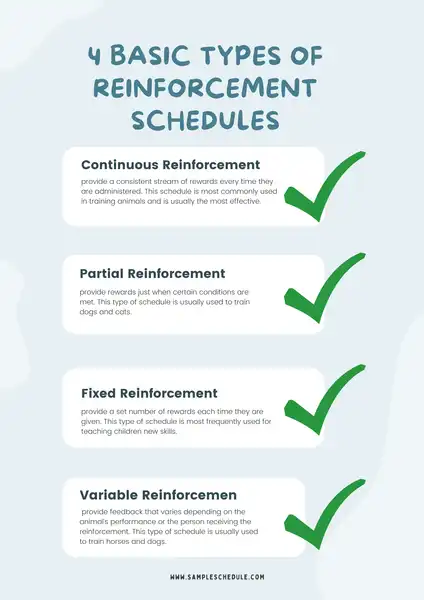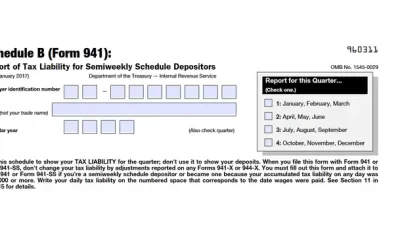To get the best of your reinforcement schedules, you need to know about the various types of schedules. Each has its advantages and disadvantages, so it’s important to choose the right one for your needs.
What are the 4 basic types of reinforcement schedules?
There are 4 basic types of reinforcement schedules: continuous, partial, fixed, and variable.
- Continuous reinforcement schedules: provide a consistent stream of rewards every time they are administered. This schedule is most commonly used in training animals and is usually the most effective.
- Partial reinforcement schedules: provide rewards just when certain conditions are met. This type of schedule is usually used to train dogs and cats.
- Fixed reinforcement schedules: provide a set number of rewards each time they are given. This type of schedule is most frequently used for teaching children new skills.
- Variable reinforcement schedules: provide feedback that varies depending on the animal’s performance or the person receiving the reinforcement. This type of schedule is usually used to train horses and dogs.

4 basic types of reinforcement schedules
What are the advantages of each type?
- Continuous reinforcement is the most common type of reinforcement schedule and is the easiest to use. Continuous reinforcement allows for controlled delivery of reinforcement, which makes it a good choice for intermittent reinforcement. It also allows for easy measurement of results, creating it a good choice for objectives that are easy to measure.
- Partial reinforcement is a good choice for intermittent reinforcement because it allows for controlled delivery of reinforcement. Partial reinforcement also allows for easier measurement of results.
- Fixed reinforcement is the least common type of schedule but can be very effective when used sparingly. Fixed reinforcement allows for more predictable delivery of rewards, making it a good choice for objectives that are easy to measure. Fixed reinforcement also has the advantage of living very reinforcing.
- Variable reinforcement is best for unpredictable rewards because it allows for more variability in the quantity of reinforcement provided. Variable reinforcement also has the advantage of being more responsive to changes in behavior.
What are the disadvantages of each type?
- A fixed schedule of reinforcement is often ineffective because it can become boring and routine over time.
- A fixed schedule of reinforcement is difficult to modify and can become frustrating if rewards are not provided as planned.
- A fixed schedule of reinforcement can be less motivating than a variable or intermittent schedule.
- Continuous reinforcement is the most common type of reinforcement schedule, but it can be less motivating than other types.
- Partial reinforcement is usually more effective than no reinforcement, but it cannot be easy to administer.
- Variable schedules of reinforcement are usually more effective than fixed schedules of reinforcement, though they can also be more challenging to use.
- Some examples of when a schedule of reinforcement might be appropriate include when a task must be repeated frequently, when the consequences for noncompliance are unpredictable, or when many rewards are needed quickly.
What are some examples of when a schedule of reinforcement might be appropriate?
When using a schedule of reinforcement, it’s important to consider the specific goal you’re trying to achieve. Some examples of when a schedule of reinforcement might be appropriate include: training a dog or other animal, rewarding desired behaviors, punishing undesired behaviors, and maintaining the desired behavior.
One of the advantages of using a reinforcement schedules is that it can be tailored to fit the specific needs of the individual. For example, you might use a continuous reinforcement schedule to train a dog to sit but switch to a partial reinforcement schedule if the dog starts to get distracted during the training sessions.
Another advantage of using a schedule of reinforcement is that it can be more effective than punishment alone. In some cases, punishment might produce quick results, but it won’t always lead to long-term change. With a schedule of reinforcement, however, you can often expect consistent results over time.
There are several things to consider when creating a reinforcement schedules.
First, you’ll need to decide what reinforcement will work best for your needs. Second, you’ll need to determine when and how often the reinforcement will be given. And finally, you’ll need to ensure that the reinforcement is delivered promptly, so it doesn’t lose its effectiveness.
What are some things to consider when creating a schedule of reinforcement?
When creating a schedule of reinforcement, it is important to consider the goals of the behavior being reinforced. Four main goals can be addressed through the use of reinforcement:
- To increase a behavior’s frequency
- To increase its duration or intensity
- To decrease its probability of occurrence
- To change its meaning
How can a schedule of reinforcement be used effectively?
When it comes to using a schedule of reinforcement, it’s important to understand the different types and advantages they provide. There are four types of schedules: continuous, partial, fixed, and variable. Each has its advantages and disadvantages, so it’s important to choose the right one for your needs.
The continuous schedule is the most common type; it rewards an animal constantly (or nearly constantly) throughout the training process. This type is best for teaching skills and behaviors, as it ensures that the animal constantly receives correct responses.
The partial schedule is a variation of the continuous schedule and provides reinforcement only after a set number of correct responses. This type is good for training animals who are difficult to reward consistently, as it gives them a chance to earn rewards more often.
The fixed schedule provides reinforcement only at certain times or occasions. This type is good for training animals who require precision in their rewards (like soldiers), as it limits the time they have to wait for rewards.
The variable schedule is a variation of the fixed schedule and provides reinforcement based on a set parameter (like how many objects a dog has searched). This type is best for treating addiction, as it allows for more precise dosing of rewards.
Understanding the different types of schedules and their advantages and disadvantages is essential when creating a schedule of reinforcement. However, be sure also to consider other factors like the animal’s personality and past performance when choosing a schedule.
Read Also: 12+ Powerful Interview Schedule Template & How to Schedule Interviews Easily
In conclusion, a schedule of reinforcement is an important tool that can be used to improve behavior in various ways. It’s important to consider each type’s advantages and disadvantages before crafting a plan to achieve the most successful results.
A reinforcement schedules is a plan that dictates when and how often reinforcement will be given. There are four basic types of reinforcement schedules: continuous, partial, fixed, and variable. Each type of schedule has its advantages and disadvantages, so it’s important to choose the right one for your needs.
The advantages of a schedule of reinforcement are that it is easy to administer and follow, it is predictable, and it can be adapted to different situations. Disadvantages of a schedule of reinforcement are that it can be ineffective if the reinforcement is not given enough times, it can be confusing, and it can be hard to change a schedule if it is not working.
Some examples of when a schedule of reinforcement might be appropriate are teaching a new skill, teaching a child how to behave, training a service animal, and conditioning a dog to perform a task.
When creating a reinforcement schedules, some things to consider are the type of behavior being reinforced, the intensity of the reinforcement, and the duration of the reinforcement.





